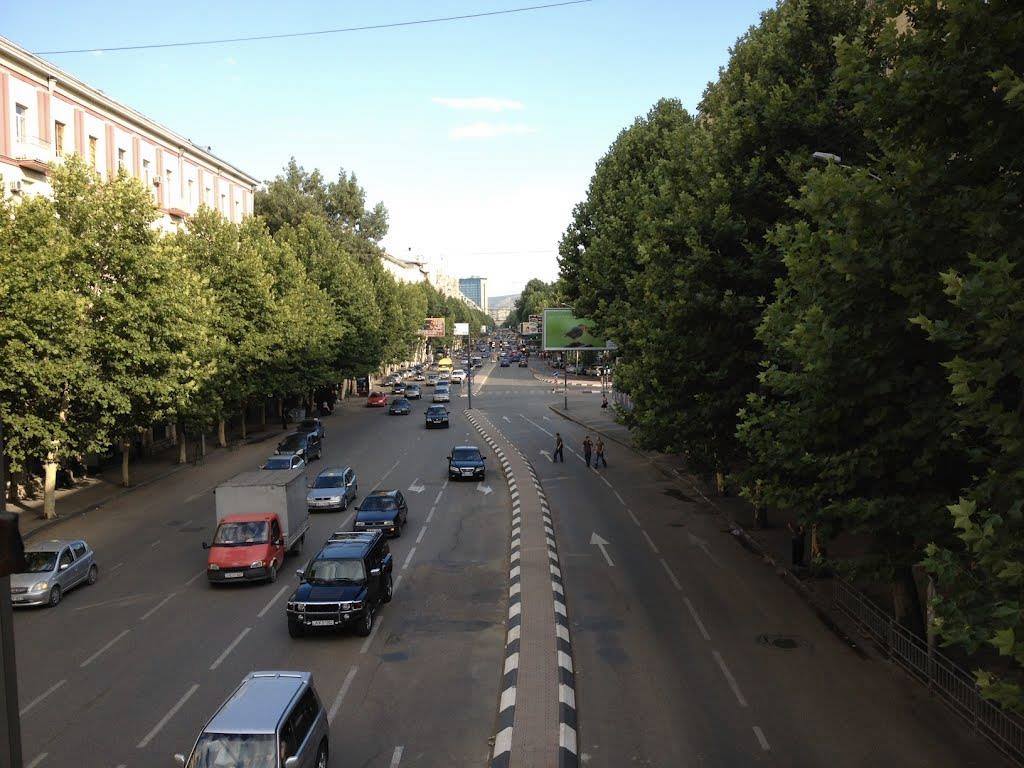Recently, the Tbilisi City Hall is considering changing Pekini Street from a two-way street to a one-way street.
If the Tbilisi City Hall goes forth with this plan, Pekini Street will become a place for people to pass through, not a place for people to live.
The elderly and children, who already find it difficult to cross across will have to walk much more distance every day to get to their destinations. Bebo can forget her mashrutka going both directions – let her walk through the underpass, and then to another street to get to the doctors.
But what is Pekini Street currently to the people of Tbilisi? A residential area, with thriving businesses and thousands of people passing through on foot daily.
Tbilisi City Hall, in short, has decided to pass over people in favour of cars.
What happens when a two-way street is converted into a one-way street? The reasoning behind Tbilisi City Hall’s decision is that cars will be able to pass through Pekini faster. But not everyone drives a car, and not everyone wants to pass through Pekini. Many people live and work in Pekini itself – Pekini is a destination, not a passageway.
There are three main reasons why Pekini Street should not change to a one-way street; 1) in high-density urban areas, streets should be designed for residents, not for cars, 2) it would severely harm local businesses, 3) one-way streets in such zones are less safe for everyone, drivers, residents and pedestrians included.
According to Caucasus Business Week , Pekini Street is ranked as one of the most promising streets to invest in, with a yield of 9.9% per annum. On two-way streets, vehicles are encouraged to stop more frequently, which gives drivers more exposure to local businesses. (Gayah, Daganzo 2012) If this change happens to Pekini, we can expect local businesses to wind down and residents to be unhappy with the levels of noise pollution, air pollution and congestion as traffic will be redirected towards the now expanded road.
A comment from a resident of Iosebidze Street, the street which runs parallel behind Pekini in between Shartave Street, suggested that traffic has significantly increased in his street because it has become the ‘parallel’ to Pekini – similar to the dynamic that exists between Petre Melikishvili Street and Merab Kostava Street. The difference is while Merab Kostava and Petre Melikishvili were designed to be wide, “traffic has significantly increased in a street which is small and not made for heavy traffic.” The resident commented, “While I am fine with temporary changes of traffic due to reconstruction this newly announced plan threatens to permanently overload Iosebidze completely.”
There are two schools in the vicinity of Pekini and Iosebidze and these changes threaten to transform a regular residential area with schools and businesses into a highway.
International expertise on urban street network design “stresses that two-way streets create higher levels of economic activity and improve the livability of downtown areas.” (Gayah, Daganzo 2012) Urban areas should be livable, and we should be empowering all members of society towards greater mobility – from the disabled, the economically disadvantaged, the elderly and our children.
Tbilisi currently lacks a transport masterplan, and therefore decisions regarding street design, bus routes and mobility lack a unified structure. Establishing a one-way street on Pekini will significantly impact transport floes in Tbilisi. Therefore, the issue requires further study, with the active involvement of road engineers, transport specialists, urban planners, the team working on the development of the Tbilisi Transport Master Plan, as well as other stakeholders. It would be reasonable to conduct in-depth analysis of possible routes for residents on nearby territories, pedestrians and drivers. It is of crucial importance to study the planned changes using a Transport Modelling software rather than gut feeling, for taxpayer’s dollars are being spent and the lives of citizens will be greatly affected.
We need safety islands for the people who cross the street daily. This would be a stop-gap measure: according to internationally recognised city planning principles, densely populated urban zones such as Pekini should widen their pedestrian areas, build bus lanes and bus stops – focusing on the experience of people living and working there. These residential zones should not be solely for passing through; they should be a community area. People deserve to feel safe in community areas, and they deserve to feel that the areas were designed for them.
There is a lot at stake economically and socially when it comes to decision making regarding one of Tbilisi’s most prominent streets. Let there be some time, expertise and effort put into discussing with stakeholders before we come to a decision – and let that decision be the right one: for people, not for cars.